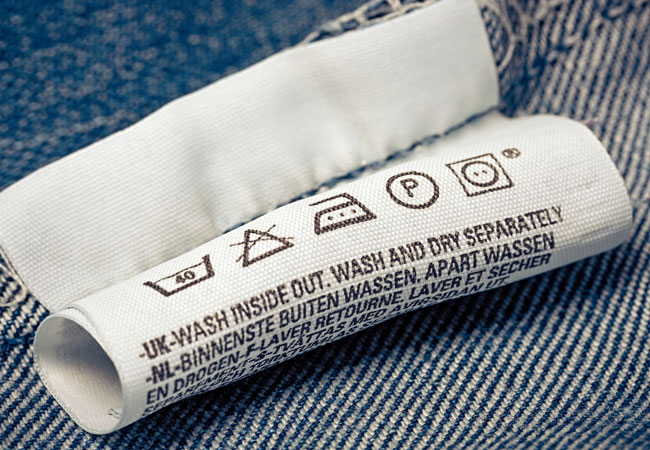We may earn revenue from the products available on this page and participate in affiliate programs. Learn More ›
Take a look at your clothing tags before your next load of laundry. If you’re lucky, they’ll include a set of fine-print instructions for care without any confusion—but, occasionally, you’ll find little more than a handful of triangles, squares, circles, and dots. How likely are you to know the laundry symbols’ meaning, especially when some icons are distinguishable by a mere dot? Remember, the stakes are high if you can’t decipher the icons or ignore them altogether; an incorrect wash, dry, or iron could lead to a shrunken favorite sweater or faded pair of pants. Thankfully, you have a cheat sheet. Follow this guide to common laundry symbols to keep your clothes and household linens in pristine condition.
WASHING LAUNDRY SYMBOLS
Perhaps the most important icons, these three symbols let homeowners know if a piece of clothing should be washed in a machine, hand washed, or dry cleaned.

1. MACHINE WASH: You can throw this item into the washer with no worries. Most cotton and synthetic fabrics are machine washable, so cleaning items like jeans and T-shirts is always a cinch.
2. HAND WASH: To clean the fabric, you’ll need to hand wash with a mild etergent. Most delicate clothing requires hand washing, since machines may stretch, shrink, or otherwise damage them.
3. DO NOT WASH: Water may ruin this fabric on contact, so you’ll need to head to your local dry cleaner and leave the washing process to the pros. Some linen, silk, rayon, and wool items often require professional dry cleaning, as do some rare specialty fabrics.
TEMPERATURE LAUNDRY SYMBOLS
Fabrics respond in various ways to hot and cold water, so take heed of these three temperature-related laundry care symbols before you begin your next load.
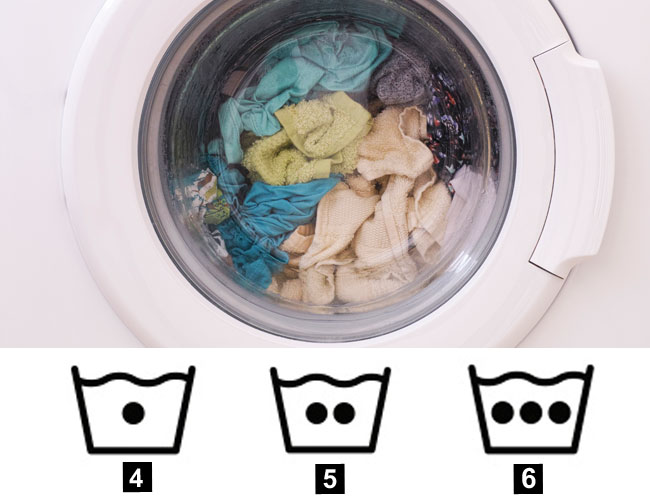
4. WASH IN COLD WATER: Some fabrics shrink in warm water, meaning you’ll want to keep them cool, whether you’re washing by hand or with a machine. Linen, silk, rayon, and wool items tend to require cold water (typically somewhere between 60 degrees Fahrenheit and 80 degrees Fahrenheit), as does cotton that hasn’t been pre-shrunk.
5. WASH IN WARM WATER: Warm water (usually around 110 degrees Fahrenheit) works best for everyday clothes in need of basic cleaning and odor removal. This symbol doesn’t necessarily mean you can’t wash them cold water; rather, it signifies that your clothes are safe in warmer water as well.
6. WASH IN HOT WATER: Hot water, which runs above 130 degrees Fahrenheit in washing machines, helps soap work more quickly and effectively—especially on stained and soiled items. That’s why hot water is preferred for towels, sheets, and other durable materials that get a lot of day-to-day use.
BLEACH LAUNDRY SYMBOLS
“To bleach or not to bleach” is a common question when you’re loading up the washing machine. The answer lies with three triangles, which can tell you when it’s safe and when it’s not advisable.
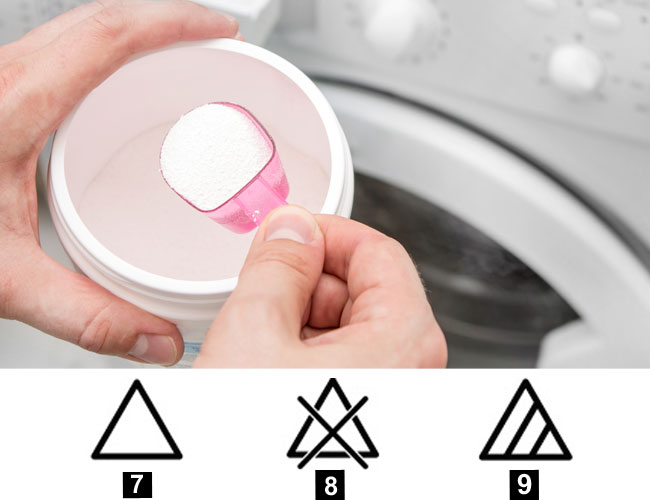
7. BLEACH IS OK: Bleach effectively whitens whites, and oxygen bleach is a gentler alternative that can add an extra cleaning kick to your laundry load. Bleach is rarely safe on wool but often safe on cotton. If using any type of bleach, add a capful to your machine’s bleach dispenser; never apply it directly to the fabric.
8.BLEACH IS NOT OK: It’s not advisable to use bleach on any item that bears this symbol on the tag, since splotches or discoloration may occur. Most white cotton and synthetic fabrics are able to handle bleach without catastrophe, but if you dare go against a laundry label’s warning, beware the potential consequences.
9. ONLY USE COLOR-SAFE BLEACH: Color-safe bleach uses hydrogen peroxide as its primary ingredient instead of chlorine bleach, and it often contains other chemicals that brighten colored clothing. This symbol indicates that homeowners can safely use a hydrogen-based product on a garment, but make sure the bottle clearly states that it’s color-safe.
DRYING LAUNDRY SYMBOLS
To prevent winding up with a pile of ruined clothes, be mindful of your label’s drying instructions. Here are four symbols to know.
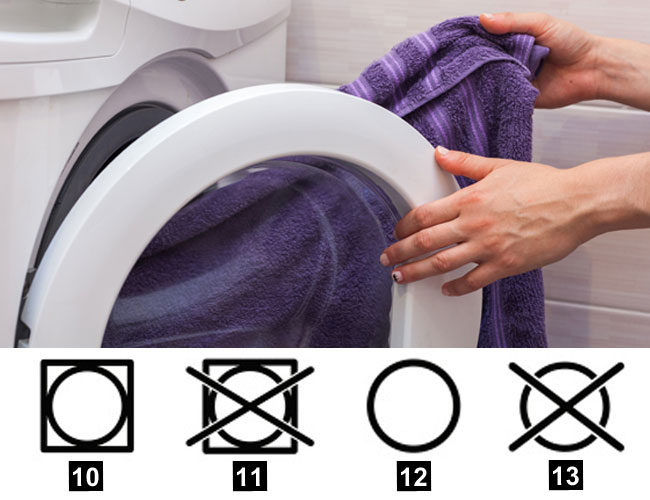
10. TUMBLE DRY: This symbol signifies that the item can safely run through a cycle in the dryer. If the circle has one dot in the middle, low heat is preferred when tumble drying. Two dots indicate a that the item can handle a maximum of medium heat, while three dots signal that high heat may be regularly used. If the icon has no dots in the middle of the circle, homeowners can dry the garment on any heat setting. Cotton, polyester, and nylon typically require low heat, while spandex, linen, and microfiber pieces are best left to tumble dry on a cool temperature.
11. DO NOT TUMBLE DRY: Putting a “do not tumble dry” item into the dryer could ruin it entirely, so always air dry any garment with this symbol. Silk, wool, suede, and high-spandex fabrics can’t usually survive a run through the machine without losing shape.
12. DRY CLEAN ONLY: For clothes with this symbol, it’s best to leave the cleaning process to the professionals, since they may fade and shrink in your laundry machines. Many silk, wool, velvet, taffeta, and acetate items require dry cleaning.
13. DO NOT DRY CLEAN: On the other hand, some clothes aren’t meant to withstand the chemicals used in the dry cleaning process. There’s almost never a need to dry clean cotton, so the more of it that you have in your wardrobe, the less often you’ll need to make a trip to the cleaners to keep your clothing fresh.
IRONING LAUNDRY SYMBOLS
Most clothes come out of the dryer looking ready-to-wear, but not all fabrics are created equal. When in doubt, iron it out—unless the label tells you not to.
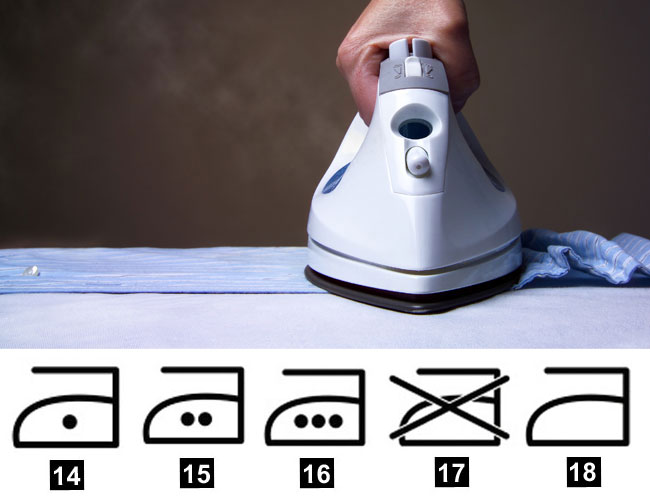
14. IRON ON LOW/COOL: If your label has an iron with one dot inside, it can only tolerate cool ironing temperatures. Set your iron to its lowest temperature and test an inconspicuous corner of the fabric to see the reaction before you iron the entire piece. Generally, synthetic fabrics are best ironed with low heat and no steam.
15. IRON ON MEDIUM: An iron symbol with two dots indicates the item can be ironed with medium or average heat. Again, dial your iron to the appropriate level and test an inconspicuous patch of fabric, just to be safe. Cashmere, flannel, and silk are often ironed on a medium setting with no steam, and the garment is usually turned inside-out while being ironed.
16. IRON ON HIGH/HOT: Fabric with this label can handle an iron on its highest setting. Linen and cotton can often be ironed and steamed on maximum heat.
17. DO NOT IRON: If your laundry label has this icon, the fabric will likely shrivel and burn if you use an iron on it, even on a low setting. If you’re in need of some crease reduction, a light application of wrinkle releaser (view example on Amazon) is your best bet.
18. IRONING ALLOWED: If you see this icon, you may use an iron on any setting, with or without steam.
